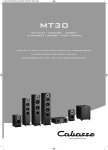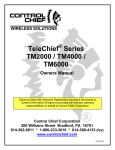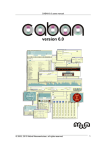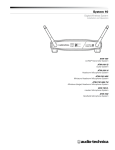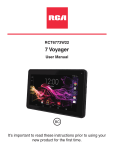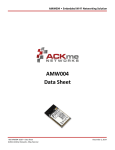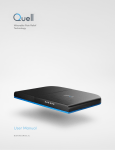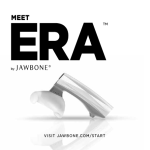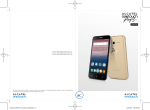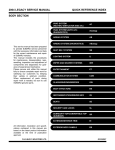Download Access1000™ Manual
Transcript
OPERATING MANUAL 95-00-0-107 Rev 002 Table of Contents 2 (28) 1Introduction______________________________________________3 2Scope___________________________________________________3 2.1 Safety Considerations_____________________________________________ 4 2.2Warnings_______________________________________________________ 6 3 4 Technical specifications___________________________________7 Description of the system __________________________________8 5 6 Description of the Access 1000™ receiver____________________9 Installation of the receiver_________________________________10 4.1Transmitter______________________________________________________ 8 4.2 Receiver 115 VAC________________________________________________ 8 4.3 Receiver 12/24 VAC/VDC_________________________________________ 8 6.1 6.2 Placement of the receiver__________________________________________ 10 Connections on the receiver _______________________________________ 11 8.1 8.2 8.3 8.4 8.5 8.6 8.7 Basic configuration_______________________________________________ 13 Advanced configuration___________________________________________ 13 Erasing transmitters in the receiver__________________________________ 14 Re- configuring a transmitter in the receiver ___________________________ 14 High Security Transmission Mode___________________________________ 15 PIN lock in the receiver___________________________________________ 16 Memory card ___________________________________________________ 17 9.1 Indications on the transmitter_______________________________________ 21 11.1 11.2 Group ID_______________________________________________________ 22 Display window illumination________________________________________ 23 7 8 9 10 11 12 13 14 14.1 14.2 15 16 Indicators on the receiver _________________________________12 Configuration of the receiver ______________________________13 Description of the Access 1000™ transmitter_____________________________20 Using the system________________________________________22 Configuration of the transmitter____________________________22 Installation of vehicle mount ______________________________24 Inserting/Replacing batteries in the transmitters______________25 Error codes_____________________________________________26 Error codes, Access 1000™ receiver_________________________________ 26 Error Codes Access 1000™ transmitter_______________________________ 26 Receiver mounting dimensions for Access 1000™____________26 Radio Warranty__________________________________________27 16.1Warranty_______________________________________________________ 27 16.2 Warranty Period_________________________________________________ 27 16.3 Warranty Service________________________________________________ 27 16.4 Excluded Parts__________________________________________________ 27 16.5Remarks_______________________________________________________ 27 17 Part Numbers___________________________________________27 Access 1000™ User Manual 95-00-0-107 Rev.002 3 (28) 1 Introduction This manual only covers the installation of the Access 1000™ radio remote door opening system. The Access 1000™ System is not a complete door opening system: it provides only the set of outputs that are driven according to the actions performed by the operator of the transmitter. The way the set of outputs is used for controlling the doors depends on the specific installation and is outside the scope of the Access 1000™. The approvals applicable to the Access 1000™ radio remote control system are only valid for the system itself. The complete remote control system, where the controlled object is one part, has to be tested and approved according to the standards/norms that are applicable and specific to the controlled object and it is not the responsibility of Control Chief Corporation. 2 Scope The following guide must be used when installing the Access 1000™ door opening system to ensure secure, safe operation. The installation must be carried out by a certified electrician. FCC Part 15 and Industry Canada RSS Notice This device complies with Part 15 of the FCC Rules and Industry Canada licenseexempt RSS standard(s). Operation is subject to the following two conditions: (1) this device may not cause interference, and (2) this device must accept any interference that may cause undesired operation of the device RSS FCC Partie 15 et du Canada Avis à Industrie Cet appareil est conforme à la Partie 15 des règlements de la FCC et Industrie Canada exempts de licence standard RSS (s). Son fonctionnement est soumis aux deux conditions suivantes: (1) cet appareil ne peut pas provoquer d'interférences et (2) cet appareil doit accepter toute interférence pouvant causer un mauvais fonctionnement du dispositif ! WARNING: CHANGES OR MODIFICATIONS NOT EXPRESSLY APPROVED BY CONTROL CHIEF® CORPORATION COULD VOID THE USER’S AUTHORITY TO OPERATE THE EQUIPMENT. Access 1000™ User Manual 95-00-0-107 Rev.002 2.1 4 (28) Safety Considerations 1. The safety guidelines in this manual are not intended to replace any rules or regulations or any applicable local, state, or federal governing laws. The following information is intended to be used in conjunction with other rules or regulations already in existence. It is important to read all safety information before operating any wireless radio remote control system. 2. Only properly trained persons designated by management should be permitted to operate wireless radio controlled equipment. Wireless radio controlled equipment should not be operated by any person who cannot read or understand signs, notices and operating instructions that pertain to the equipment. 3. Wireless radio controlled equipment should not be operated by any person with insufficient eyesight or hearing or by any person who may be suffering from a disorder or illness or is taking any medication that may impair judgment or the ability to operate equipment. 4. Ensure transmitter batteries are in good condition and power for receiver is correct. Installation and maintenance should be done only while the controlled equipment main power and receiver’s power are off and locked out to prevent electrical shock. 5. Any person operating wireless radio controlled equipment should possess the following knowledge and/or skills: • Knowledge of hazards particular to the equipment being operated • Knowledge of safety rules for radio controlled equipment • Knowledge of the radio transmitter • Proper clearance of all moving parts on the radio controlled equipment • Proper storage space for radio control transmitter when not in use • Transferring radio control transmitter to another person • Reporting unsafe or unusual operating conditions • Remote controlled equipment functions and limitations • Procedures for testing controlled equipment 6. The Access 1000™ remote control system is for the remote operation of door opening equipment. This unit is not intended for use on material handling, people moving or any other critical application. Access 1000™ User Manual 95-00-0-107 Rev.002 5 (28) 7. Radio controlled operators should always position themselves for the best view of the equipment they are controlling. The equipment should never be operated blindly. The operator should always remain at a safe distance, without losing line of sight with the equipment. 8. Transmitter switches should never be mechanically blocked ON or OFF for any equipment motion. 9. After daily operation, a secure storage space should be designated for the transmitter unit especially when not in use. This precaution is intended to prevent unauthorized use of the equipment. 10. The equipment operator should keep all body parts away from the door they are controlling. Do not attempt to operate the system without checking door for obstructions. Warning: SECURE THE WIRELESS REMOTE CONTROL TRANSMITTER PRIOR TO PERFORMING ANY MAINTENANCE. 11. The equipment has been tested for correct operation before delivery from the factory. However, it must not be used in critical or hazardous operation where incorrect operation may cause personal or equipment damage. If the equipment fails to respond or behaves improperly, the equipment operator should NOT operate the equipment AND should notify his/her supervisor immediately. When serious conditions are noticed (conditions that make the equipment unsafe to operate), the equipment should be shut down immediately and the supervisor notified. Caution: THE RECEIVER UNIT AND/OR RELAYS ARE NOT RATED AS EXPLOSION PROOF. THE RECEIVER UNIT MUST NOT BE INSTALLED OR OPERATED IN EXPLOSIVE ENVIRONMENTS UNLESS APPROPRIATE SECONDARY ENCLOSURE MEASURES ARE TAKEN. Warning: THE UNIT MUST BE WIRED TO THE CORRECT VOLTAGE; FAILURE TO DO SO MAY DAMAGE THE SYSTEM. Access 1000™ User Manual 95-00-0-107 Rev.002 2.2 6 (28) Warnings 1. Read this manual carefully before operating and installing this product. 2. Due to the complex nature of equipment, it is necessary to read the entire manual before installation. 3. Only authorized personnel should service this equipment. Unauthorized work on this unit will void the warranty. 4. This manual is for reference only; please call your distributor or Control Chief if further assistance is required. 5. The equipment has been tested for correct operation before delivery from the factory. However, it must not be used in critical or hazardous operation where incorrect operation may cause personal or equipment damage. 6. After daily operation, a secure storage space should be designated for the transmitter unit especially when not in use. 7. Transmitter should be placed in a safe place when not in use to avoid accidental pressing of buttons. 8. The equipment should be equipped with all required safety devices as dictated by OSHA, or all other applicable governing regulations. 9. Ensure transmitter batteries are in good condition and power for receiver is correct. 10. Installation and maintenance should be done only while the equipment’s main power and receiver’s power are off and locked out to prevent electrical shock. 11. Contents of the manual may be amended by the manufacturer without notice. Access 1000™ User Manual 95-00-0-107 Rev.002 3 7 (28) Technical specifications Table 1. Technical Specifications, Access 1000™ System System Specifications Operating frequency: 926.5 MHz Channel separation: 25 kHz Power output: < 5 mW Functional sensitivity: <= -107 dBm BER 10-4 Transmission principle: GMSK, TDMA, Operating temperature: -13°F - 131°F (-25°C - +55°C) Storage temperature: -40°F - 185°F (-40°C - +85°C) Receiver specifications: Enclosure rating IP65 Power supply: 115 VAC 60 Hz 15 mA, 4AT fuse. 12/24 VDC/VAC 150 mA Max switching capacity of relays: 2A/250VAC with cosφ=1 Total load on all relays: 4A/250VAC (not exceeding 2A on any single relay) Relay- type SPDT Fuse on current loop: 2.5AT/250VAC (IEC 60127-2/V) Dimensions: 135 x120 x 50 mm Weight: 1 lb. (450g) Screw size: TX20 Transmitter Specifications: IP- class: IP67 Dimensions: 120x75x30 mm Weight: .4 lb. (200g) Battery type: (2) AA 1.5V Alkaline Screw size: PH2 Access 1000™ User Manual 95-00-0-107 Rev.002 8 (28) 4 Description of the system 4.1 Transmitter (Part Number:81-10-0-008) This document covers the Access 1000™ transmitter. Important features are: 4.2 4.3 • A transmitter suitable for controlling up to 1000 different doors/receivers • Integrated back lighted display • Belt clip included (Part Number: 81-941426-000) • Optional vehicle mount with external power Receiver 115 VAC (Part Number:81-20-0-007) • 115 VAC 60Hz powered • 3 Single Pole Double Throw relays • Integrated display and configuration buttons • Memory capacity: up to 500 transmitters • The receiver can be equipped with an detachable memory card containing a backup of all configuration parameters Receiver 12/24 VAC/VDC (Part Number:81-20-0-008) • 12/24 VAC/VDC powered • 3 Single Pole Double Throw relays • Integrated display and configuration buttons • Memory capacity: up to 500 transmitters • The receiver can be equipped with an detachable memory card containing a backup of all configuration parameters Access 1000™ User Manual 95-00-0-107 Rev.002 5 Description of the Access 1000™ receiver9 (28) 1 Figure 1. 2 3 4 Access 1000™ 1. Power connection 2. Connection to relay 1, ARROW UP or 3. Connection to relay 2, STOP or 4. Connection to relay 3, ARROW DOWN or Access 1000™ User Manual 95-00-0-107 Rev.002 6 10 (28) Installation of the receiver The permanent installation of the receiver must include fuses that protect the equipment and wiring from overcurrent and short-circuit. The power supply of the receiver and all relay contacts must be fused. All fuses are used as disconnecting devices. The fuses shall be easily accessible, and have to be placed in the line pole. Note that the fuse must be compatible with IEC 60127-2/V. After the installation of the equipment, the installed cables must be bound together in pairs (i.e. by using a cable binder) very close to the terminal blocks. Note that there might be hazardous voltage in the receiver, therefore only certified electricians are allowed to open the lid. 6.1 Placement of the receiver Select a location that is within the environmental limitations of the receiver and where it is difficult for unauthorized persons to obtain access to the receiver. If possible, mount the receiver with the cable glands facing downwards. For the mounting dimensions of Access 1000™ see chap.15. The receiver is preferably mounted with 4 mm screws. Access 1000™ User Manual 95-00-0-107 Rev.002 11 (28) Connections on the receiver The receiver is equipped with connections for relays and power. Access by removing 6 Torx TX20 screws and cover. (see fig. 1 and fig. 2). The connections for power connection are, from left to right: • Line (L) • 12/24 AC/DC (L) (+) • Neutral (N) • 12/24 AC/DC (N) (-) OR The connections for each relay are, from left to right: • Common terminal • Normally opened (NO) • Normally closed (NC) Figure 2. Power connection and Relay connection Connection example: • R1 = UP or • R2 = STOP or • R3= DOWN or Replace cover and TX20 screws torque to 2.0 Nm (1.5 lb-ft) Access 1000™ User Manual 95-00-0-107 Rev.002 12 (28) 7 Indicators on the receiver The Access 1000™ model has an integrated display that shows additional system relevant information (Fig. 3). At activation of a certain function, the transmitter memory position will be shown in the display window. If a relay is activated, the following will be shown in the display: • Left decimal point: Relay 1 activated • Both decimal points: Relay 2 activated • Right decimal point: Relay 3 activated • Number of used memory position At start up, the display will show system information in the following order: • System version • “ r ” if a memory card is installed • Programmed door number Figure 3. 3 4 Access 1000™ model display and buttons 1. Learn/Erase button 2. Enter button 3. Memory position up button 4. Memory position down button 5. Display 5 1 2 Access 1000™ User Manual 95-00-0-107 Rev.002 13 (28) 8 Configuration of the receiver 8.1 Basic configuration 1. It is optimal to learn the transmitter(s) to the receiver prior to mounting if the receiver is not mounted in an easily accesible position. 2. Install batteries in the transmitter. (see section 13) 3. Choose the door number that shall be used (0-999) and enter the number on the transmitter 4. Apply power to the receiver. 5. Press the “Learn/Erase” button. The display window shall show “L r n” followed by the memory position that the transmitter will be stored in. The right decimal on the display flashes as long as the Learn mode is active (10 seconds). 6. Press ARROW UP on the transmitter The display shows “A C C” if the learn process is successful and the receiver will return to normal operating mode automatically. The display will now show the new door number. 8.2 Advanced configuration This configuration allows the user to choose at what memory position a certain transmitter shall be stored in. Adding a transmitter in a certain memory position 1. Press the “Learn/Erase” button. The display window shall show “L r n” followed by the memory position that the transmitter will be stored in. The right decimal on the display flashes as long as the Learn mode is active (10 seconds) Access 1000™ User Manual 95-00-0-107 Rev.002 14 (28) 2. To select what memory position to use (memory positions can be 1-500) press the Memory Position UP or Memory Position DOWN buttons (see fig. 3). The left decimal on the display indicates whether the chosen memory position is already used. 3. Press ARROW UP on the transmitter The display will show “A C C” and will return to normal operating mode. 8.3 Erasing transmitters in the receiver Erasing individual transmitters 1. Press the “Learn/Erase” button. The display shows “L r n” followed by the memory position that will be erased. This mode will be active for 10 seconds. 2. Change what memory position to delete (1 to 500) by using Memory Position UP “+” and Memory Position DOWN “-” buttons. The left decimal in the display window indicates whether the memory position is in use or not (note that two decimals are shown in the display). 3. Press the “Learn/Erase” button to remove the selected memory position. The display will show “D E L” and return to normal operation. Erasing all transmitters 1. Press the “Learn/Erase” button. The display shows “L r n” followed by the memory position that will be erased. This mode will be active for 10 seconds. 2. Press the “Learn/Erase” button for 5 seconds to erase all memory positions. The display will show “D E L” “A L L” and return to normal operation. All transmitters are now erased from the receiver memory and, if connected, the memory card. Access 1000™ User Manual 95-00-0-107 Rev.002 8.4 15 (28) Re- configuring a transmitter in the receiver If the user attempts to program a transmitter that is already programmed in the receiver, the display will show “E r r 1” followed by the original memory position on the display. Erase the original memory position before proceeding with the configuration. 8.5 High Security Transmission Mode The High Security Transmission Mode uses encrypted authentication to ensure that the receiver only replies to commands from transmitters stored in the memory. This mode makes it difficult to scan and record messages that could, with the right technology, open doors without using an authentic coded transmitter. Jumper J1 1 2 R1 Figure 4. 3 4 5 R2 6 7 8 9 R3 Jumper J1 shown with high security transmission mode enabled. To access Jumper J1 pinch both white pins located on either side of the display card and remove card. To enable the High Security Transmission Mode, place jumper J1 as show in Figure 4 above. Restart the receiver. At startup, the display will show “S E C”. (Warning: The four white, flat buttons located on the display card may pop off easily.) The high security mode will slightly increase the response time and reduce the operating range. Access 1000™ User Manual 95-00-0-107 Rev.002 8.6 16 (28) PIN lock in the receiver The Access 1000™ receiver can be protected from unauthorized configuration by using a 4-digit PIN-code. When a PIN-code is configured, all buttons on the receiver are locked except the button used to enter the code (Enter button). 8.6.1 8.6.2 To configure the PIN-lock do the following: • Power on the receiver • ress the Enter button and hold it down for 5 seconds. The display should P now show “Pin new” followed by “_ _ _”. If the user is inactive for more than 10 seconds in the PIN configuration mode the receiver will return to normal operations • nter the first digit of the code by using the ‘+’ and ‘-‘ buttons. Press the ‘EnE ter’ button when finished • Repeat the above step for digits 2-4 • hen all 4 digits are entered the display will show ‘rpt’ (repeat). The code W must be repeated to be accepted. Enter the code once more • If the code is entered successfully the display will show ‘Sto’ (stored) • he receiver will automatically be locked after 10 seconds of button inactivity. T The display will show “LOC” when the learn/erase button is depressed To unlock the receiver do the following: • ress the Enter button and hold it down for 5 seconds. The display should P now show “Pin” followed by “_ _ _”. If the user is inactive for more than 10 seconds in the PIN configuration mode the receiver will return to normal operations • nter the first digit of the code by using the ‘+’ and ‘-‘ buttons. Press the ‘EnE ter’ button when finished • Repeat the above step for digits 2-4 Access 1000™ User Manual 95-00-0-107 Rev.002 8.6.3 17 (28) • hen all 4 digits are entered correctly the display will show ‘PAS’ (passed) W and the buttons on the receiver will be unlocked for 60 seconds. If the PIN is incorrect the display will show ‘Err’ • he receiver will automatically be locked after 60 seconds of button inacT tivity. The receiver can also be manually locked by pressing the Enter button for 5 seconds. The display will show “LOC” when the learn/erase button is depressed To change/delete Receiver PIN do the following: • 8.7 The PIN can only be changed by unlocking the receiver and making a “delete all” erasing all configurations on the receiver (if applicable) Memory card A memory card is useful in applications where many transmitters are used to control one single receiver. The receiver can be equipped with a detachable memory card containing a backup of all configuration parameters. If a receiver needs replacement, the user only has to install a new receiver of the same type and insert the memory card in the new receiver in order to get the same functionality as in the old receiver. If more receivers with the same configuration are needed, remove the card and perform the copy operation on a new receiver. Access 1000™ User Manual 95-00-0-107 Rev.002 8.7.1 18 (28) Copying information from a memory card to a new receiver 1. Turn the power off the receiver. 2. Unscrew the 6 screws holding the receiver lid. 3. Carefully remove the display card. 4. Insert the memory card that you want to copy in the memory card slot in the receiver (see fig. 5). 5. Mount the display card in the display card slot (see fig. 5). 6. Start the receiver. The display will show “C P Y” when the copy operation is completed. Note that the memory in the receiver has to be empty before copying the memory card to the receiver (see chap. 8. 3 for information on how to delete the memory). 7. If the memory card will be used to copy the configuration on to other receivers or if the memory card shall be used as a backup, remove it. If not, mount the lid and tighten all screws with TX 20, torque 2.0 Nm (1.5 lb-ft). Access 1000™ User Manual 95-00-0-107 Rev.002 8.7.2 19 (28) Copying information from a receiver to a memory card Note that the memory card has to be empty before copying the receiver memory to the card. To remove information from a memory card, insert the card in a new receiver and erase all transmitters (see chap. 8.3). 1. Turn the power off the receiver. 2. Unscrew the 6 screws holding the receiver lid and remove the lid. 3. Carefully remove the display card by pinching both white pins located on either side of the card. 4. Insert the memory card that you want to copy all parameters to in the memory card slot (see fig. 5). 5. Mount the display card in the display card slot (see fig. 5). 6. Start the receiver and wait for approx. 5 seconds. The display will show “C P Y” “ to” “CRD” when the copy operation is completed. 7. Remove the display card and the memory card. If the memory card shall be stored; store it in a clean environment free from static electricity. 8. Mount the display card and the lid. Tighten all screws with TX 20 torque 2.0 Nm (1.5 lb-ft). 1 2 Figure 5. Access 1000™ User Manual Memory card and display slots in the receiver 1. Memory card slot 2. Display slot 95-00-0-107 Rev.002 9 20 (28) Description of the Access 1000™ transmitter 1 Figure 6 2 3 4 5 6 Figure 7 Figure 6. The Access 1000™ transmitter indicators and buttons. 1. Indicator LED. 2. Display 3. Function buttons (from left to right ARROW UP, STOP, ARROW DOWN) (Figure 7: from left to right OPTIONAl LIGHT, UP/STOP/ DOWN/, OPTIONAL HORN/WARNING) 4. Numeric Entry 5. Increase display value 6. # Decrease display value * Figure 7. 1.Optional transmitter depicts a button configuration appropriate for single relay operated doors. (Please contact a Control Chief sales representative with any questions or for more information.) Access 1000™ User Manual 95-00-0-107 Rev.002 21 (28) 9.1 Indications on the transmitter 9.1.1 LED indicator Normal operation Quick flashing RED = sending message. Continuous GREEN = Relay activated in the receiver (Feedback information from receiver). Battery warning 3 long RED flashes = Battery depleted, transmitter cannot send commands. Continuous RED after activating command = Low battery. 9.1.2 Display The display shows system- relevant information during start up and operation. At startup, the transmitter software version followed by battery voltage is displayed. After this, the transmitter enters normal operation mode. In this mode, the display shows the door number that will be activated if any of the TOP ROW buttons are pressed. If the display indicates “L O 9.1.3 b A T”, replace the batteries. Buttons on the transmitter The transmitter is equipped with 15 buttons, namely ARROW UP, STOP, ARROW DOWN, buttons 0-9, and #. * ARROW UP, STOP and ARROW DOWN buttons are used for controlling the door movements. 0-9 buttons are used for selecting what door to control. * The function buttons and # are used for increasing and decreasing the door number shown in the display. Access 1000™ User Manual 95-00-0-107 Rev.002 10 22 (28) Using the system In order to control a door, enter the door number using the transmitter buttons, check that the correct number has been configured in the receiver on the display, and press the desired function (ARROW UP, STOP or ARROW DOWN). The buttons and # can be used to either increase or decrease the value shown in the display respectively. * 11 Configuration of the transmitter 11.1 Group ID All Access 1000™ transmitters have a factory pre-programmed unique identity (ID). This is a number between 1000000 and 16777214. In addition to the pre-programmed unique ID, the Access 1000™ transmitter has support for Group ID. A group ID consists of a six digit number that the user can configure on the transmitter. Transmitters with the same Group ID is considered identical by the controlled receivers. This means that transmitters can be organized in groups. This increases the flexibility and simplifies the maintenance on large installations. Each receiver is capable of learning/storing up to 500 Group IDs, one for each position on the memory card. If no Group ID is configured, the transmitter will use factory ID settings. 11.1.1 Configuration of the Group ID in the transmitter 1. Choose a suitable Group ID (either a new code, 000001 to 999999 or an group code already in use). 2. Remove the back side of the transmitter (see fig. 8). 3. Remove one battery. * 4. Press the bottom left button ( )on the transmitter while inserting the battery. 5. Continue pressing the button until the text “A i D” is displayed in the transmitter display. Access 1000™ User Manual 95-00-0-107 Rev.002 23 (28) 6. Enter the six digit code using the keyboard (the transmitter LED will flash once for each button that is pressed). After the entire code has been entered in the transmitter, the transmitter display will show “A i d” followed by the entered value. 7. Save the entered Group ID by pressing “#” button on the transmitter within 10 seconds. If the Group ID has been accepted, the display window will show “S T O”. 8. Verify the transmitter functionality by testing the transmitter on a receiver with the correct Group ID. 9. Replace the back side of the transmitter (see fig. 10). The transmitter can be restored to factory settings by entering “000000” as ID. For safety reasons, only group ID’s less than 100000 can be viewed using this configuration method. 11.2 Display window illumination The display on the Access 1000™ transmitter has built in automatic illumination that can be ON or OFF. Typically, the battery life will increase by turning the illumination OFF. 11.2.1 Configuration of the display window illumination 1. Remove the back side of the transmitter (see fig. 8 ). 2. Remove one battery. 3. Press the bottom right button (#)on the transmitter while inserting the battery. 4. Continue pressing the button until the text “L e d” is displayed in the transmitter display. 5. The new settings (“O N” or “O F F”) will be shown in the display. 6. Verify the transmitter functionality. 7. Mount the back side of the transmitter (see fig. 10 ). Access 1000™ User Manual 95-00-0-107 Rev.002 12 24 (28) Installation of vehicle mount Connect the vehicle mount to 12/24V DC where the brown wire is connected to (+) and the blue wire to ground (-). When the cable has red and black wires, connect red wire to the (+) and the black wire to ground (-). If the cable is connected wrong a fuse inside the vehicle mount will blow. Replacement fuse manufacturer:Littelfuse, part number: 0453001. To change the fuse: 1. Remove power from the vehicle mount. 2. Open the vehicle mount by unscrewing the two screws on the backside. 3. Lift the card up and use a tweezer to remove the old fuse and replace it with the new one. 4. Mount the card and lid and tighten the screws with PH2. 5. Current draw is 12mA - Standby, 30mA - Operating. 1 2 3 Figure 8. 1. Fuse placement on card 2. Card placement in vehicle mount 3. Brown (red)(+) and blue(black)(-) cable Access 1000™ User Manual 95-00-0-107 Rev.002 13 25 (28) Installing/replacing batteries in the transmitter If the display on the transmitter indicates “L O b A T”, replace the batteries promptly. Note that changing of batteries must take place in a clean environment free from static electricity. The batteries are changed as follows: 1. Open the battery cover by unscrewing the 6 screws on the backside of the transmitter housing (see fig. 9). 2. Carefully remove the cover by lifting up the front end of the cover (see fig. 11). Figure 9. Back side of the cover inserted in its position. 3. Remove the batteries. 4. Insert the new batteries (using AA Alkaline only). 5. Batteries must be inserted correctly with polarity shown in the battery well. 6. Close the cover by first inserting the backside of the cover in the transmitter, and the pressing the front down (see fig. 11). 7. Tighten the 6 screws with PH2 (torque 1 Nm). Figure 10. Batteries in the transmitter Figure 11. Battery cover and the screws holding the cover Access 1000™ User Manual 95-00-0-107 Rev.002 14 26 (28) Error codes 14.1 Error codes, Access 1000™ receiver Table 2. Error codes Access 1000™ ID already programmed 1 Memory full 2 Memory card mismatch during power up 10 Memory card write error. Maybe memory card has 11 been removed during operation. Memory card copy to verify error 12 Internal errors. The unit needs service 3, 5 30, 31 and 32 Line power unstable 4 14.2 Error Codes Access 1000™ transmitter Setting Group ID, timed out =1 Buttons stuck at start-up =6 If any other error codes are displayed, the transmitter needs service by an authorized service center. 15 Receiver mounting dimensions for Access 1000™ 120 mm 102 mm 145 mm Access 1000™ User Manual 102-103,5 mm Use 4 mm screws to mount the receiver. 120 mm Figure 12. 95-00-0-107 Rev.002 16 27 (28) Radio Warranty 16.1 Warranty. Control Chief Corporation guarantees that this equipment meets its published specifications at the time of shipment from the factory. This equipment will perform as described if installed properly. However, Control Chief cannot guarantee that operation of remote control system is absolutely error-free, or without interruption. 16.2 Warranty Period. This equipment is warranted against defects in materials and workmanship for a period of one (1) year from the date of shipment. During the warranty period, Control Chief is responsible for necessary repairs/replacement as long as the product can be proven defective. 16.3 Warranty Service. For warranty service or repair, this equipment must be returned to Control Chief Corporation. Customer is responsible for shipping charges to Control Chief. Control Chief’s warranty covers only parts and factory labor. No onsite in and out charges are covered under this warranty. 16.4 Excluded Parts. This warranty does not include consumable parts such as joysticks, batteries, fuses, buttons, and relays. Also, this warranty does not cover defects caused by improper installation, improper/insufficient maintenance, unauthorized modification, improper operation, ignorance of environmental specifications, and/or improper software/interfacing. 16.5 Remarks. No other warranty is expressed or implied, except for the above mentioned. The remedies provided herin are the buyers’ sole and exclusive remedies. Control Chief shall not be liable for any direct/indirect, special, incidental or consequential damage. Consult Control Chief’s general warranty for further information. 17 Part Numbers Transmitter 81-10-0-008 Receivers 81-20-0-007 and 81-20-0-008 Vehicle Mount 81-60-4-004 Belt Clip 81-941426-000 Access 1000™ User Manual 95-00-0-107 Rev.002 R Control Chief Corporation Box 141, 200 Williams Street, Bradford, PA 16701 Phone 814.362.6811 | 800.233.3016 Fax 814.368.4133 E-mail [email protected] www.controlchief.com © Control Chief Corporation, 2012




























